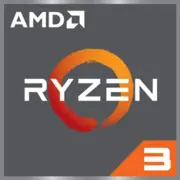AMD Ryzen 3 PRO 5450U

AMD Ryzen 3 PRO 5450U: Compact Power for Everyday Tasks
April 2025
Introduction
AMD’s Ryzen 3 PRO laptop processors have always been positioned as reliable solutions for business and everyday tasks. The Ryzen 3 PRO 5450U, released in 2021, remains relevant in the budget segment due to its balance of performance and energy efficiency. In this article, we will discuss who this chip is suitable for in 2025, how it competes with contemporary counterparts, and what to pay attention to when choosing a device.
Architecture and Manufacturing Process
Cezanne-U: 7nm Efficiency
The processor is built on the Zen 3 architecture (codename Cezanne-U) and manufactured using the TSMC 7nm FinFET process, which provides high transistor density and low power consumption.
- Cores and Threads: 4 cores, 8 threads.
- Frequencies: Base — 2.6 GHz, maximum in turbo mode — 4.0 GHz.
- Cache: 8 MB L3, which accelerates data processing in multitasking scenarios.
- Integrated Graphics: AMD Radeon Graphics (Vega architecture, 6 compute units, frequency up to 1600 MHz).
Architecture Features:
- Supports PCIe 3.0 (not PCIe 4.0, which may limit SSD speed in high-end configurations).
- Optimized for multi-threaded tasks: simultaneous work with documents, browsers, and light video editing applications.
Power Consumption and TDP
15W TDP: Quiet and Cool
The thermal package of 15W allows the processor to be used in ultrabooks and compact laptops without active cooling.
- Operating modes: In idle mode, the frequency drops to 1.2 GHz, saving battery charge.
- Heat Dissipation: Even under full load, the temperature rarely exceeds 70°C, eliminating throttling in thin chassis.
Example: The Lenovo ThinkBook 14 G3 with the Ryzen 3 PRO 5450U operates nearly silently while browsing the internet.
Performance in Real Tasks
Office and Multimedia
- Geekbench 6: 1523 (single-core), 4853 (multi-core). This is sufficient for working with Office 365, Zoom, and 10+ tabs in Chrome.
- Video Editing: Rendering a 1080p clip in Premiere Pro will take 20% longer than with the Ryzen 5 5600U, but is acceptable for short clips.
Gaming
- iGPU Radeon Graphics: In Dota 2 (on low settings, 720p) — 45-55 FPS; CS:GO — 60 FPS. Perfect for indie games (Hollow Knight, Stardew Valley).
- Turbo Mode: When plugged in, the processor maintains 3.8 GHz for up to 10 minutes, then stabilizes at 3.2 GHz.
Use Case Scenarios
Who is the Ryzen 3 PRO 5450U Suitable For?
1. Students: Working with texts, online courses, Netflix.
2. Office Workers: Email, spreadsheets, video conferencing.
3. Budget-Conscious Users: Laptops based on this chip cost $500-700 (e.g., HP ProBook 445 G8).
Not Suitable For:
- Gamers requiring Ultra settings in AAA games.
- Video editors working with 4K footage.
Battery Life
Up to 10 Hours of Operation
- Power-Saving Technologies:
- Precision Boost 2: Dynamic frequency changes based on load.
- Cool’n’Quiet: Disabling unused cores.
- Real Tests: At a screen brightness of 150 nits — 8-9 hours of web surfing, 6 hours of video.
Tip: Choose laptops with a battery of at least 50 Wh for maximum autonomy.
Comparison with Competitors
1. Intel Core i5-1135G7 (Tiger Lake, 2020):
- Better single-thread performance (+10% in Geekbench), but worse multi-thread performance (-15%).
- Iris Xe graphics are 20-30% faster but more expensive.
2. Apple M1 (2020):
- Advantages in energy efficiency (up to 15 hours of operation) and SSD speed.
- Weaker in compatibility with Windows programs.
3. AMD Ryzen 5 5500U:
- 6 cores/12 threads, 30% faster in rendering, but retains a TDP of 15W.
Pros and Cons
Strengths:
- Low laptop prices.
- Energy efficiency and quiet operation.
- Sufficient performance for basic tasks.
Weaknesses:
- No PCIe 4.0 support.
- Graphics are weaker than Intel’s Iris Xe.
- Limited future-proofing (2025).
Laptop Selection Recommendations
1. Type of Device: Ultrabooks (Acer Swift 3) or business laptops (Lenovo ThinkPad E14).
2. Memory and SSD: Minimum 8 GB of RAM (better 16 GB) and 256 GB SSD.
3. Screen: Full HD IPS matrix for comfortable work.
4. Ports: USB-C, HDMI, Wi-Fi 6 for future-proofing.
Example: ASUS VivoBook 15 M513 — lightweight (1.7 kg), touchscreen, priced at $650.
Final Conclusion
Ryzen 3 PRO 5450U is an optimal choice for those who need an inexpensive, reliable laptop for studying, office tasks, or travel. Its key advantages include battery life, low heat output, and sufficient power for everyday tasks. However, in 2025, it would be advisable to consider it a temporary solution: models based on the Ryzen 5 7000 series or Intel’s 12th generation offer more performance for the same price.
Who is it Suitable For:
- Budget users.
- Those who value portability.
- Corporate sector (due to PRO security features).
Main Benefit: The price, energy consumption, and performance ratio remains one of the best in its class.
Basic
CPU Specifications
Memory Specifications
GPU Specifications
Miscellaneous
Benchmarks
Compared to Other CPU
Share in social media
Or Link To Us
<a href="https://cputronic.com/en/cpu/amd-ryzen-3-pro-5450u" target="_blank">AMD Ryzen 3 PRO 5450U</a>